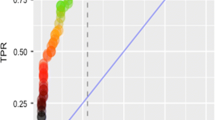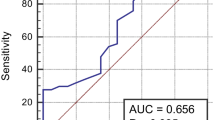Key summary points
Identification of predictors of short-term death after spontaneous intracerebral hemorrhage (SICH) in the elderly.
AbstractSection FindingsThe short-term case fatality (38.7%) after SICH is high in the elderly. Hematoma volume, decreased level of consciousness and functional reserve, but not age per se, increase the risk of short-term death.
AbstractSection MessageAge per se should not justify any decision of withholding best treatment in elderly SICH patients. Offering the best acute treatment can potentially improve the clinical outcome.
Abstract
Aim
The incidence of spontaneous intracerebral hemorrhage (SICH) increases with age. Data on SICH mortality in the very old are sparse. We aimed to describe the predictors of 30-day SICH mortality in the very elderly in southern Portugal.
Methods
A total of 256 community representative SICH patients aged ≥ 75 years (2009–2016) were included. Multiple logistic regression was used to identify predictors of 30-day mortality.
Results
Mean age was 82.1 years; 57.4% males. The 30-day case fatality was 38.7%. The frequency of patients taking anticoagulants (29.3% vs. 11.5%); comatose (46.9% vs. 2.5%); with hematoma volume ≥ 30 mL (64.6% vs. 13.4%); intraventricular dissection (78.8% vs. 27.4%) was higher in deceased patients (p < 0.05). Survivors were more often admitted to stroke unit (SU) (68.2 vs. 31.3%) and had lower mean admission glycaemia values (p < 0.05). The likelihood of death was increased in patients with higher admission hematoma volume (≥ 30 mL) (OR: 8.817, CI 1.753–44.340, p = 0.008) and with prior to SICH history of ≥ 2 hospitalizations OR = 1.022, CI 1.009–1.069, p = 0.031). Having higher Glasgow coma scale score, OR: 0.522, CI 0.394–0.692, p < 0.001, per unit was associated with reduced risk of death. Age was not an independent risk factor of short-term death.
Conclusions
The short-term mortality is high in very elderly SICH. Prior to SICH history of hospitalization, an indirect and gross marker of coexistent functional reserve, not age per se, increases the risk of short-term death. Other predictors of short-term death are potentially manageable reinforcing the message against any defeatist attitude toward elderly patients with SICH.


Similar content being viewed by others
Data and code availability
On reasonable request.
References
van Asch CJ, Luitse MJ, Rinkel GJ et al (2010) Incidence, case fatality, and functional outcome of intracerebral haemorrhage over time, according to age, sex, and ethnic origin: a systematic review and meta-analysis. Lancet Neurol 9:167–176. https://doi.org/10.1016/S1474-4422(09)70340-0
Nzwalo H, Nogueira J, Félix C et al (2017) Incidence and case-fatality from spontaneous intracerebral hemorrhage in a southern region of Portugal. J Neurol Sci 380:74–78. https://doi.org/10.1016/j.jns.2017.07.006
Poon MTC, Fonville AF, Salman RAS (2014) Long-term prognosis after intracerebral haemorrhage: Systematic review and meta-analysis. J Neurol Neurosurg Psychiatry 85:660–667. https://doi.org/10.1136/jnnp-2013-306476
Pozsegovits K, Kazuo S, Nagy Z (2006) Epidemiology of stroke in the elderly. Ideggyogy Sz 59:449–453
Mattiuzzi C, Lippi G (2020) Worldwide disease epidemiology in the older persons. Eur Geriatr Med 11:147–153. https://doi.org/10.1007/s41999-019-00265-2
Muenz R (2007) Aging and demographic change in European societies: main trends and alternative policy options. Soc Prot Word Bank 2–5
Nzwalo H, Nogueira J, Félix AC et al (2018) Short-term outcome of spontaneous intracerebral hemorrhage in Algarve, Portugal: retrospective hospital-based study. J Stroke Cerebrovasc Dis 27:346–351. https://doi.org/10.1016/j.jstrokecerebrovasdis.2017.09.006
Arboix A, García-Eroles L, Massons J et al (2000) Acute stroke in very old people: Clinical features and predictors of in-hospital mortality. J Am Geriatr Soc 48:36–41. https://doi.org/10.1111/j.1532-5415.2000.tb03026.x
Olsen TS, Andersen KK (2014) Stroke in centenarians. Geriatr Gerontol Int 14:84–88. https://doi.org/10.1111/ggi.12058
Forti P, Maioli F, DomenicoSpampinato M et al (2016) The effect of age on characteristics and mortality of intracerebral hemorrhage in the oldest-old. Cerebrovasc Dis 42:485–492. https://doi.org/10.1159/000448813
Chiquete E, Ruiz-Sandoval MC, Álvarez-Palazuelos LE et al (2007) Hypertensive intracerebral hemorrhage in the very elderly. Cerebrovasc Dis 24:196–201. https://doi.org/10.1159/000104477
Saracci R (2007) Survival-related biases survive well. Int J Epidemiol 36:244–246. https://doi.org/10.1093/ije/dyl263
Stein M, Hamann GF, Scharbrodt W et al (2012) Intracerebral hemorrhage in the very old future demographic trends of an aging population. Stroke 43:1126–1128. https://doi.org/10.1161/STROKEAHA.111.644716
Camacho E, Lopresti MA, Bruce S et al (2015) The role of age in intracerebral hemorrhages. J Clin Neurosci 22:1867–1870. https://doi.org/10.1016/j.jocn.2015.04.020
Béjot Y, Bailly H, Graber M et al (2019) Impact of the ageing population on the burden of stroke: The dijon stroke registry. Neuroepidemiology 52:78–85. https://doi.org/10.1159/000492820
Zisberg A, Shadmi E, Gur-Yaish N et al (2015) Hospital-associated functional decline: the role of hospitalization processes beyond individual risk factors. J Am Geriatr Soc 63:55–62. https://doi.org/10.1111/jgs.13193
Hemphill JC, Bonovich DC, Besmertis L et al (2001) The ICH score. Stroke 32:891–897. https://doi.org/10.1161/01.str.32.4.891
Forman R, Slota K, Ahmad F et al (2020) Intracerebral hemorrhage outcomes in the very elderly. J Stroke Cerebrovasc Dis 29:30–31. https://doi.org/10.1016/j.jstrokecerebrovasdis.2020.104695
Keep RF, Hua Y, Xi G (2012) Intracerebral haemorrhage: mechanisms of injury and therapeutic targets. Lancet Neurol 11:720–731. https://doi.org/10.1016/S1474-4422(12)70104-7
Martinez J, Mouzinho M, Teles J et al (2020) Poor intensive stroke care is associated with short-term death after spontaneous intracerebral hemorrhage. Clin Neurol Neurosurg. https://doi.org/10.1016/j.clineuro.2020.105696
Parry-jones AR, Sammut-powell C, Paroutoglou K et al (2019) An intracerebral hemorrhage care bundle is associated with lower case fatality. Ann Neurol 86:495–503. https://doi.org/10.1002/ana.25546
Ungerer MN, Ringleb P, Reuter B et al (2020) Stroke unit admission is associated with better outcome and lower mortality in patients with intracerebral hemorrhage. Eur J Neurol 27:825–832. https://doi.org/10.1111/ene.14164
Jiménez Caballero PE, LópezEspuela F, Portilla Cuenca JC et al (2013) Charlson comorbidity index in ischemic stroke and intracerebral hemorrhage as predictor of mortality and functional outcome after 6 months. J Stroke Cerebrovasc Dis 22:1–2. https://doi.org/10.1016/j.jstrokecerebrovasdis.2012.11.014
Author information
Authors and Affiliations
Contributions
AB, JN, AV, RO and PG collected the primary data. AM undertook the statistical analyses. AM, SP and HN had oversight of the project. All authors contributed to revision and intellectual content of the final submission.
Corresponding author
Ethics declarations
Conflict of interest
The authors declare that they have no conflict of interest.
Ethical approval
The institutional review board approved the project. Due to its retrospective nature, informed consent was waived.
Additional information
Publisher's Note
Springer Nature remains neutral with regard to jurisdictional claims in published maps and institutional affiliations.
Rights and permissions
About this article
Cite this article
Batista, A., Osório, R., Varela, A. et al. Prediction of short-term prognosis in elderly patients with spontaneous intracerebral hemorrhage. Eur Geriatr Med 12, 1267–1273 (2021). https://doi.org/10.1007/s41999-021-00529-w
Received:
Accepted:
Published:
Issue Date:
DOI: https://doi.org/10.1007/s41999-021-00529-w




